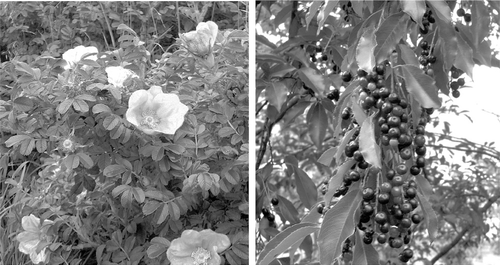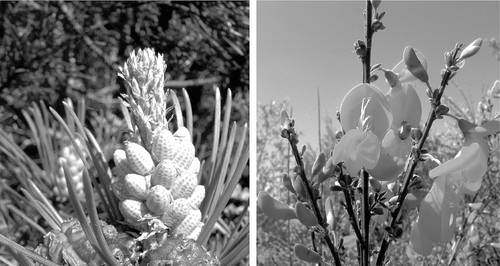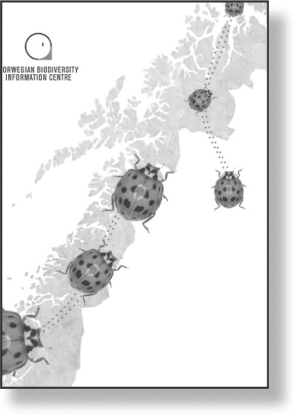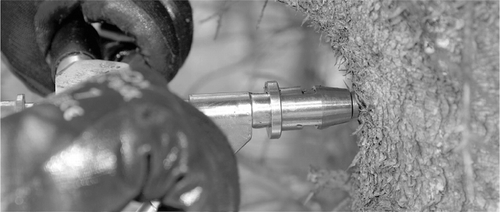Photo: Wikimedia commons.

Introduced species in a changed climate –how should we handle the risks?
Introducing exotic tree species offers an attractive solution to dealing with a warmer climate. However, it is a solution associated with risk. What are the guarantees that the exotics don't become invasive and turn out to be a problem? An SNSsupported project draws the conclusion that introductions will still be needed, but must be undertaken with caution and based on experience.
The project “Risk assessment of new forest tree species” (SNS-114) was a desk study reviewing and discussing the knowledge base in Scandinavia with respect to the trade-off between ecological risk and the usefulness of exotic tree species in the context of climate change. It was also a project within the Selfoss declaration on sustainable forestry. The project, running for the period 2011–2012, was coordinated by Professor Erik Dahl Kjær.
Climate envelopes
Future climate is uncertain, but the responses of species and populations are even more difficult to predict. Natural distributions depend on a complicated interplay between abiotic and biotic factors, life characteristics of the species, phenotypic plasticity and the degree of genetic variation associated with the adaptive traits of the species; and, not least, the impact of human activities.
This means that climate is only one factor determining the success of a species. Nevertheless, researchers have long predicted the potential distribution of species with the aid of climate envelopes. A climate envelope refers to the range of climatic conditions that are suitable for a species – usually the conditions where the species grows well and can establish itself today. Using climate envelope modelling, it is possible to draw maps of individual species in a predicted warmer climate.
Models show that many species now thriving at more southern latitudes have the potential to grow well in the Nordic countries if the climate warms, and many of these could become important new forest trees. However, they might need help – assisted migration is the term – to overcome the slow natural migration and gene flow.
Danish experiences
The review focuses on four recent introductions to Denmark. They were all actively introduced. Other species have been introduced unintentionally, facilitated by transport corridors such as railways or road verges, along water systems or as incidental contaminants in seed, grain or soil.
Photo: Wikimedia commons.

Black cherry (Prunus serotina) is native to North America, introduced to central Europe as early as the 17th century. It has been planted in woodland, hedgerows and game shelters. The species seldom grows above a height of 10 m in Europe. Black cherry is classified as a forestpest, and is on the list of the 100 worst invasive species in Europe compiled by the EU-funded project DAISIE. It spreads easily in open natural vegetation and woodlands, and forms monocultures in the under-storey, preventing regeneration of native woody species.
Despite the fact that the species was known to be invasive, it continued to be planted on the Jutland peninsula, Denmark, as late as in the 1980s. It has been shown to colonise new areas quickly, for example after the severe storm in 1999. Seedlings may persist up to six years as small plants, waiting for disturbances in the woodland canopy, after which they outgrow and over-shadow other woody species.
Control is very difficult. The species exhibits clonal growth, and it is almost impossible to eradicate the trees simply by felling them. The most commonly applied control method is to fell the trees and use herbicides on the stumps. Where this is not possible, repeated cutting, root-extirpation or grazing is applied. However, treatment must be continued for several years, otherwise clearance can be the start of accelerated expansion.
Japanese rose (Rosa rugosa) is the most common invasive plant in Denmark. It was introduced to Europe in 1796 as an ornamental, and has been planted due to its resistance to wind and tolerance of poor soil conditions. It is naturalised throughout Denmark and is invasive in fixed dunes and other coastal habitats. Techniques for effective control include digging, cutting, grazing or the use of herbicides, and, as for black cherry, control must be continued for several years.
The dwarf mountain pine (Pinus mugo) is native to central and southeast Europe. It has been planted to stabilise dunes in northwestern Europe, but has subsequently become invasive. Pinus mugo was heavily used in afforestation in Denmark, with a maximum of 44.000 hectares planted around 1900. Pinus mugo does not resprout from cut stumps or through root-suckers, and is relatively easy to control. Restoration of previously planted dunes is now taking place, replacing the pines with indigenous species.
Common broom (Cytisus scoparius) is a leguminous shrub native to western and central Europe. It has become an invasive species in many parts of the world. It is now a troublesome weed in Denmark, forming up to 3 m high, dense thickets ousting the original vegetation. It spreads easily by seed and resprouts readily after cutting. It is difficult to control, but establishment of trees, which over-shadow the bushes, is one alternative.
Norwegian black list
Norway has taken a step towards a uniform assessment of the risk associated with introduced species. The method takes into account the species’ mode of invasion (dispersal and establishment) and ecological impact. Species with a rapid spread and severe impact are classified as high-risk. In the review article, the classification of 28 tree species introduced primarily for forestry purposes is presented.
Class A is associated with a very high risk, including high invasion potential and severe ecological effects. It includes well-known conifers such as Picea sitchensis, Pinus mugo and Larix decidua. Their risk classification is because of their spread into coastal heathland, which is designated as a threatened natural habitat. Tsuga heterophylla is also a class A species, because it effectively establishes in forested areas where it may displace other native species.
Class B consists, in Norway, of three conifer species (Abies alba, Picea glauca and Pinus peuce). These species are expected to have limited effects on native species but may have the capacity to change the state of up to 5% of one or more natural habitats.

Class C, species with a potentially high risk, includes species with either limited spread and high ecological impact, or high spread and low impact. Pinus contorta and P. cembra belong to the latter group.
Class D, low risk species, accounts for more than half of the assessed tree species. In this group neither spread and establishment nor ecological impact is sufficient to suggest a significant ecological risk. The Norwegian Biodiversity Information Centre (Artsdatabanken) has conducted a complete review of risk assessment of vascular plants.
Introduce with care
An overall conclusion of the review is that introductions of new species should be undertaken on a pilot scale. Species that show an ability to spread readily, are difficult to control and/ or are likely to invade disturbed landscapes should be handled with caution.
However, exclusive use of species that are currently considered native to a given area may not prove a sustainable long term solution, because the magnitude of predicted climate change suggests that species will shift their natural distribution areas in the future.
Read more:
www.nordicforestresearch.org, browse SNS research, Research projects.
Contact: Professor Erik Dahl Kjær, Forest & Landscape, University of Copenhagen. [email protected]
Shortcuts
Norway
Three more years for CenBio
The midterm evaluation by the Research Council of Norway was positive for the Bioenergy Innovation Centre (CenBio), which has now secured financial support for the coming three years. The objective of the centre is “to develop the basis for a sustainable, cost-effective bioenergy industry in Norway in order to achieve the national goal of doubling bioenergy use by 2020.” CenBio is a consortium set up by leading research groups and key bioenergy companies in Norway.
Read more: www.sintef.no
Denmark
Expanding the use of OpenSource GIS
Copenhagen University arranged a user seminar on the free OpenSource GIS-programme QGIS, which has been launched as version 2.0. According to Forest & Landscape Denmark, this free programme is equivalent to commercial GIS products. A Danish user group has been established.
“The use of OpenSource GIS in Denmark has been restricted to small, independent units. If we cooperate, we can better use and develop the programme”, says lecturer Lene Fischer on the website of Forest & Landscape Denmark.
Read more: sl.life.ku.dk
Finland
Forest cutting changes understorey vegetation
The Finnish Forest Research Institute, Metla, has studied the impacts of forest cutting on understorey vegetation. Grasses and herbs increased, while bilberry and cowberry declined after regeneration cutting. Twenty years after cutting, bilberry cover was only a quarter of the original level in mature stands. During the same period, cowberry almost regained its original, pre-cutting level.
Read more; Metla Bulletin 2 2013
Sweden
Hormone treatment will boost production of improved seed
Gibberellin is a plant hormone that has been shown to enhance the production of male and female flowers in trees. The hormone has been used and tested by scientists for a long time, but it has been difficult to scale up its use due to legal restrictions. One product, called “Gibb Plus Forest” is now registered for use in seed orchards in Sweden, and its registration extends until 2019. The company Svenska Skogsplantor, which propagates plants, has treated 145 hectares of Norway spruce seed orchards in 2013.
Contact: Curt Almqvist, Skogforsk
Sweden
Researchers consider that 270 wolves are enough
A group of wildlife researchers at the Swedish University of Agricultural Sciences (SLU) has written an open letter in which they state that 270 is the appropriate maximum number of wolves in Sweden, in contrast to the 380 suggested by the Swedish Environmental Protection Agency. The researchers are worried about the polarised debate on wolves in Sweden, and the lack of a longterm adaptive management plan.
Read more: www.slu.se

